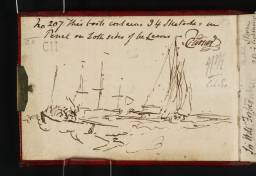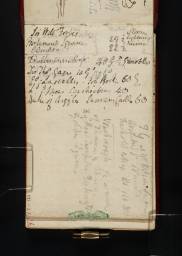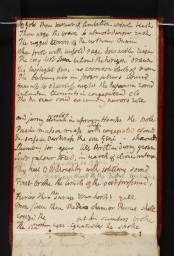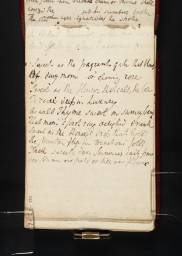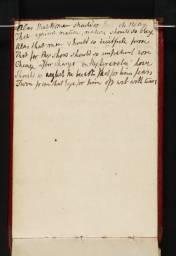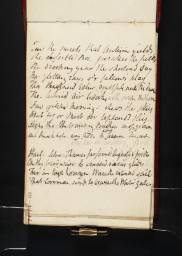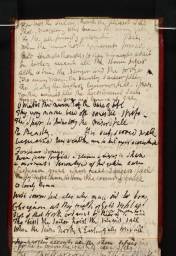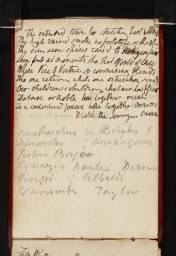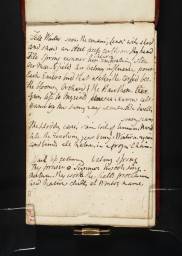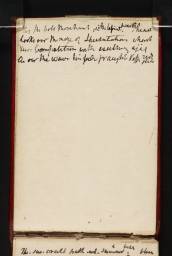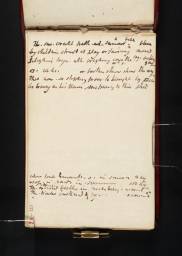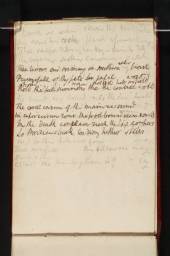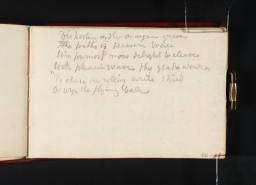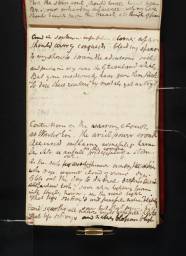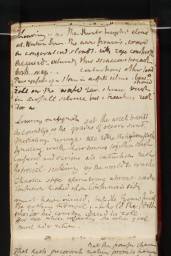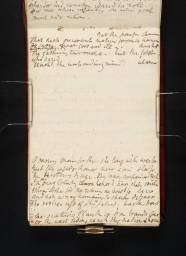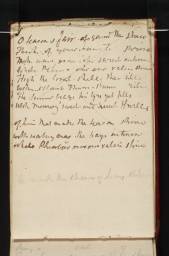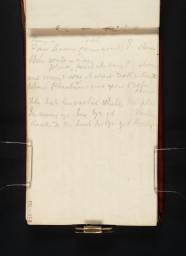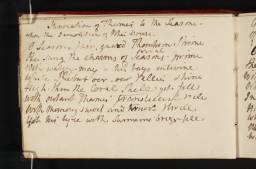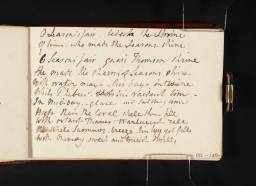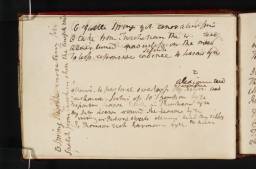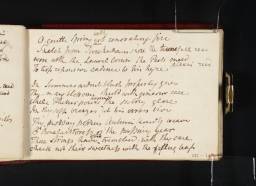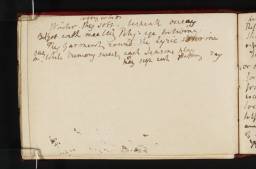Turner Bequest CII
Pocket book, bound in red calf, with pencil holder and one brass clasp
55 leaves of white wove paper
Approximate page size 76 x 115mm
55 leaves of white wove paper
Approximate page size 76 x 115mm
Inscribed by Turner in ink on a label on the spine (D40666) ‘62’
Endorsed by the Executors of the Turner Bequest in ink ‘No. 207 This book contains 34 Sketches in Pencil on both sides of the leaves’, and signed by Charles Turner in ink ‘C. Turner’, and by John Prescott Knight and Charles Eastlake in pencil ‘JPK’ and ‘C.L.E.’ inside front cover. A further endorsement by John Ruskin is recorded by Finberg: ‘207. Interesting MSS. and some stage groups’
Endorsed by the Executors of the Turner Bequest in ink ‘No. 207 This book contains 34 Sketches in Pencil on both sides of the leaves’, and signed by Charles Turner in ink ‘C. Turner’, and by John Prescott Knight and Charles Eastlake in pencil ‘JPK’ and ‘C.L.E.’ inside front cover. A further endorsement by John Ruskin is recorded by Finberg: ‘207. Interesting MSS. and some stage groups’
Accepted by the nation as part of the Turner Bequest 1856
Exhibition history
References
This small sketchbook belongs to the group used along the Thames from circa 1805, but in which Turner addressed a number of projects and concerns. Its name, apparently originating with Finberg, derives from various sketches of Greenwich including the Royal Hospital, the park and the adjacent Thames. These were presumably made in connection with London, exhibited at Turner’s Gallery in 1809, and there are also drafts of poetry related to the verses Turner attached to the picture. Other drafts relate to the demolition of the poet Alexander Pope’s villa at Twickenham in 1807 and more to Pope’s fellow poet James Thomson to whom Turner dedicated another picture for his gallery in 1809, Thomson’s Aeolian Harp. Two or even three poems seem to be in preparation here. Inside the front cover is a sketch related to a third picture in Turner’s Gallery in 1809, Shoeburyness Fisherman Hailing a Whitstable Hoy. Thus Finberg’s guess at a date of 1808 is probably correct for most of the contents of the book. However, notes of payments and commissions from Walter Fawkes are probably from 1809 and 1810, as is the draft of a request for postponement of Turner’s Perspective Lectures at the Royal Academy. Further notes connected with the lectures are undated.
The Thames sketches are not all at Greenwich as has been generally thought, but include views of the City and St Paul’s Cathedral and a few of the river west of London as well. At Greenwich Turner drew the Royal Hospital from the river and from the park, where he climbed the hill to the Royal Observatory. Gerald Wilkinson speculated that Turner was planning ‘a composition, perhaps of fishing boats, at river-level in Greenwich’ but opted to paint the view from the park in London (Tate N00483).1 Related sketches are on folios 47 verso–48 and 48 verso (D06813–D06814, D06815).2 Sketches of stags and deer also anticipate the picture although the painted versions differ. The closest relationship between sketchbook and picture seems to lie in the associated verses, the lines added by Turner in the printed catalogue for the 1809 exhibition at his gallery being already hinted at in a passage on folio 4 verso (D06728). These might be the intended conclusion of a longer poem begun on folio 1 verso (D06722), addressed to ‘gold thou parent of Ambition’s ardent blush’ and characterised by Andrew Wilton as ‘concerned with the subjects of commerce and exploration, and their implications for British national pride’.3
London was bought by Walter Fawkes, apparently in preference to Shoeburyness Fisherman (National Gallery of Canada, Ottawa)4 for which however he probably exchanged it later on; Turner’s sketch inside the front cover (D40667) is an alternative composition for Shoeburyness, with a man-of-war in a different position. Watercolours bought or commissioned by Fawkes are listed on folio 53 (D06824) and inside the back cover (D40668). The latter list comprises ten works, covered by a banker’s draft dated ‘Feb. 20’, and may date from 1809, after what is thought to have been Turner’s first visit to Farnley Hall in the summer of 1808. However, it is proposed elsewhere in this catalogue that Turner also visited Farnley in summer 1809, leaving the possibility that the payment occurred the following February. The same works, with another ten, appear on folio 53; this larger list is undated but was probably made around the time of Turner’s visit to Farnley in summer 1810. Of particular interest is the citation ‘Armistice Rock’, confirming that Fawkes had taken over the commission for Mont Blanc, from Fort Roch, in the Val d’Aosta (private collection)5 from Edward Lascelles, to whom it is accredited in a presumably earlier list of patrons and commissions on folio 1 (D06721).Turner’s new description emphasises the peacetime status of the subject, as seen during the Peace of Amiens in 1802, and suggests that he already envisaged the companion wartime version that became The Battle of Fort Rock, Val d’Aouste, Piedmont, 1796 (Tate D04900; Turner Bequest LXXX G). Taken together, these notes and lists show Turner reviewing his accounts with his patrons as part of an ongoing assessment of his income; see also the Finance sketchbook (Tate D08283–D08359; D40898–D 40901; D41431; Turner Bequest CXXII).
Pope’s Villa at Twickenham, during its Dilapidation appeared at Turner’s Gallery in 1808 (on the London art market in 2008).6 It was Turner’s elegy for the poet’s Thames-side house, demolished in 1807 by order of Baroness Howe; see especially notes to the River sketchbook (Tate D05961–D06071; D40650–D40654; Turner Bequest XCVI), which contains verses by Turner related to his ode ‘On the Demolition of Pope-House at Twickenham’ in his Verse Book (private collection).7 Folios 10 verso–12 (D06740–D06741) of the present book have alternative opening lines of an ‘Invocation of Thames to the Seasons – upon the Demolition of Pope’s House’ but in which another important topic is James Thomson, poet of the Seasons (1730) and Pope’s near-neighbour at Richmond who, as Turner puts it in a touching phrase, ‘caught the truth of Nature & her dyes’ (folio 55; D06828). Much of Turner’s poetry here describes seasonal climate and the strong vein of patriotism felt throughout is Thomsonian too, while mentions of ‘Thompson’s Shrine’ and his poetic lyre link up with the themes of Turner’s larger picture Thomson’s Aeolian Harp shown at his Gallery in 1809 with accompanying verses (Manchester Art Gallery).8
Turner saw both his painted and poetic tributes to Pope and Thomson as complementary and the sketchbook is evidence of his overlapping ideas. Other examples of these are his references on folios 1 verso and 6 verso (D06722, D06732) to the explorer Hugh Willoughby and his ill-fated attempt in 1553 to find a North-East Passage to China and India for the Company of Merchant Adventurers. Willoughby died trapped in ice on the coast near Murmansk and conceivably this is a clue to otherwise-mysterious drawings of ice-bound ships in the Boats, Ice sketchbook (Tate D06618–D06715; D40801–D40803; Turner Bequest CI; especially folios 17 and 18, D06636, D06637) if these were not, like other sketches of the frozen Thames in the same book, directly inspired by the great frost of 1814. Two watercolour vignettes of the 1830s (private collection; and with W/S Fine Art, London 2007), usually thought to be whaling subjects, might also represent Willoughby’s expedition.9
Of the various notes in the sketchbook for Turner’s lectures as Professor of Perspective at the Royal Academy, the extended commentary on reflected and refracted light beginning on folio 15 (D06749) was first published in almost complete form by John Gage, who noted that it refers to commentary by Joshua Reynolds on C.A. Du Fresnoy’s De Arte Graphica.10 Probably related to the fifth in Turner’s series of lectures, it includes remarks on pictures by Old Masters, among them Correggio’s Nativity (‘La Notte’) (Gemäldegalerie, Staatliche Kunstsammlungen, Dresden), Rembrandt’s Mill (National Gallery of Art, Washington DC) and probably Van Dyck’s Rachel de Ruvigny, Countess of Southampton (National Gallery of Victoria, Melbourne). Folio 24 verso (D06767) has separate commentary on versions of Raphael’s Tapestry Cartoons, Paul and Barnabus at Lystra and Paul Preaching at Athens, presumably from the set of copies by James Thornhill that hung in the Academy’s Great Room where the lectures were given.
Maurice Davies has drawn attention to the draft of a request by Turner for postponement of his lectures and extra preparation time, on folio 23 (D06764). Davies suggests that Turner could have been put off by controversy surrounding John Soane’s lectures as Professor of Architecture, which began in 1809, or simply by fear of adverse comparison with Soane’s exacting standards.11 The Academy Council Minutes of ?10 February 1810 record that Turner ‘agreed to postpone’ his own lectures until the following season, and they were first delivered in 1811. Turner’s interest in his Academy colleagues is evident from folio 29 (D06776), first noticed (but not transcribed) by Gage.12 Here, Turner makes very sceptical comments on the views of his friend Anthony Carlisle, the Academy’s Professor of Anatomy, and a new psychological fad, Craniology, recently imported from Vienna where it had been invented by Dr Franz Joseph Gall. His notes consider the structure of the eye, the mind as the seat of perception, and whether anatomical knowledge rather than mathematics or geometry had produced truth to nature in ancient sculpture. Taken together, Turner’s remarks underline his liberal interpretation of his brief and determination to range far beyond linear perspective alone.
Technical notes
How to cite
David Blayney Brown, ‘Greenwich sketchbook c.1808–10’, sketchbook, March 2007, in David Blayney Brown (ed.), J.M.W. Turner: Sketchbooks, Drawings and Watercolours, Tate Research Publication, December 2012, https://www

